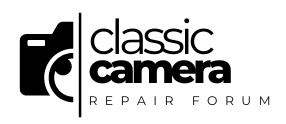How best to begin a review but in the author’s own words? Chapter 1 (subtitled: It’s harder. It takes longer. The results are no better. So why do you do it?) begins:
Just once in a while, one sees in a crowd a photographer who stands out from the mass of camera enthusiasts who rush to seize imagined decisive moments with their motor drives and zoom lenses. He uses a separate hand-held exposure meter and takes his time. His camera does not make a repetitive noise like a duchess sneezing, nor clatter like a distant scrapyard when the shutter is fired. A discreet click is the only evidence of his having recorded the world about him on film.
This book is not a repair tome as most of the other books on this webpage, although the author gives many tips on reliability and possible faults in several old cameras. And tells the reader which ones are more likely to be dependable users. Rather it is a book to introduce one to the existential pleasures of classic camera photography.
Matanle, an avid photographer, has peopled this delightful book, at the end of each chapter, with many pictures of his family and friends. A mood of compassionate familiarity is set by these examples. All taken with the very cameras described in that chapter. Within each chapter there is a plethora of professionally taken photos of the cameras, 320 Illustrations in total.
Most books on classic cameras are dull lists of specifications and time lines. Not so here, here you will find descriptions of the form and feel of the cameras, the author’s personal likes and dislikes. Their idiosyncrasies and histories come alive in the many marquee comparisons. Oh yeah, there is a four page list of cameras at the end of the book for those who must have one. Also small lists of lenses, etc. are scattered here and there, but they aren’t often enough to put one to sleep. Shutter speeds and aperture sizes are interwoven into each cameras story.
There are too many makes and models of cameras described to even think of completely listing here. But suffice it to say he describes a LOT of cameras. Entire chapters are spent on Leica, Contax, Rolleiflex, but even in these chapters he thinks to compare marquee’s. Though many classics, like Canon’s Canonet series, I would have liked shown and compared weren’t. Perhaps because the author lives in England where a whole different range of cameras were available. He did describe several I had never heard of. Or perhaps the limited space available, regardless it is a very fine book and well worth owning.
My only complaint with this book (published by Thames & Hudson) is the same one I made of Matanle’s SLR book. The spine is coming undone even with the single complete reading and a few thumbings from the two months I’ve owned it. Perhaps the hardback versions are sturdier? I have 25 year old paperback Carl Shipman photo books (HPBooks) that have been handled many more times that are holding up better.

